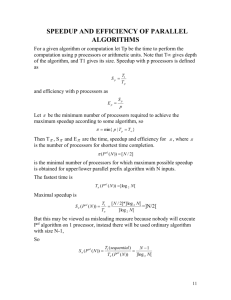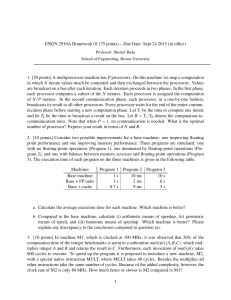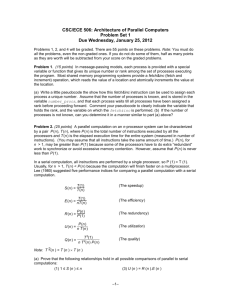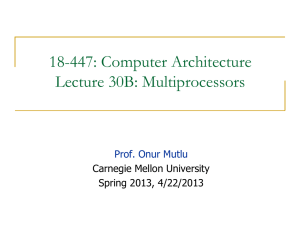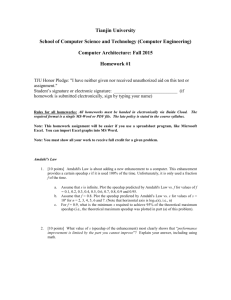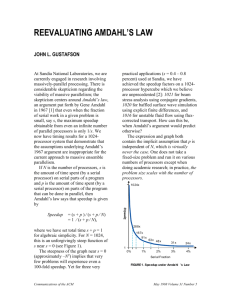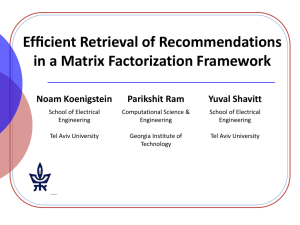Lecture 3 - Ece.eng.wayne.edu
advertisement
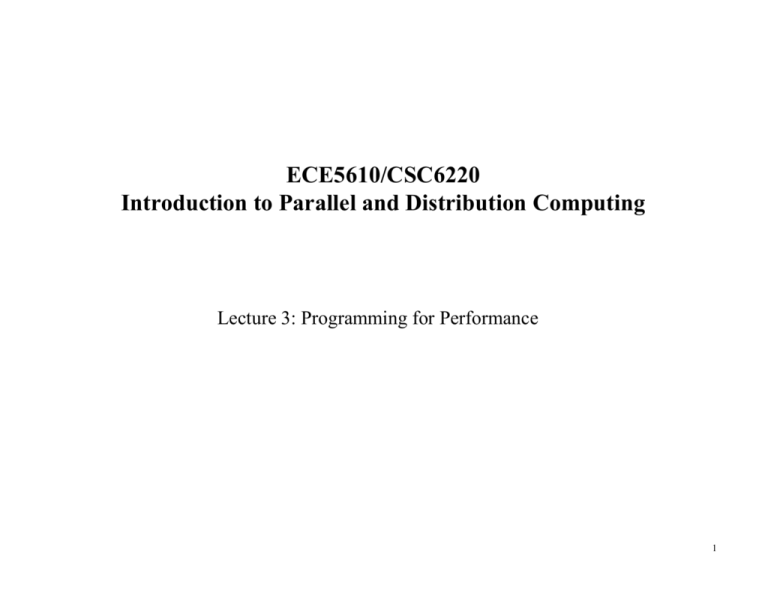
ECE5610/CSC6220 Introduction to Parallel and Distribution Computing Lecture 3: Programming for Performance 1 Performance Goal: Speedup • • Architects’ Goal ¾ Observe how program uses machine and improve the system design to enhance performance ¾ Solutions: high-performance interconnect, efficient implementation of coherence protocol and synchronization primitives … Programmers’ Goal • observe how the program uses the machine and identify and remove performance bottlenecks. 2 What Limits Performance of Parallel Programs? • Available parallelism • Load balance ¾ Some processors do more work than others ¾ Some work while others wait ¾ Remote resource contention (such as I/O services) • Communication • Extra work ¾ Management of parallelism ¾ Redundant computation 3 An Analogy: Limit in Speedup due to Available Parallelism Suppose a person wants to travel from city A to city C via city B. The routes from A to B are in mountains and the routes from B to C are in desert. The distances from A to B , and from B to C are 80 miles and 200 miles, respectively. From A to B, have to walk at speed of 4 mph From B to C, walk or drive • Question 1: How long will it take for the entire trip by walking? ¾ Answer: 80/4 + 200/4 = 70 hours • Question 2: How much faster if the trip from B to C is by a car as opposed to walk? (at speed of 100 mph) ¾ Answer: 70/ (80/4 + 200/100) = 3.18 • Question 3: What is the maximum speedup by increasing driving speed? ¾ Answer: 70/ (80/4 + 200/infinite ) Î 3.5 4 Limited Concurrency: Amdahl’s Law • Most fundamental limitation on parallel speedup • Amdahl’s law: if fraction f of sequential execution is inherently serial, speedup <= 1/f Assuming ideal speedup for the non-serial part: (p is # of processors.) Speedup factor is given by: ts p S(p) = = fts + (1 − f )ts /p 1 + (p − 1)f ≤ 1/f Efficiency factor is given by: Efficiency(p) = S(p)/p ≤ 1/(fp) 5 Limited Concurrency: Amdahl’s Law ts fts (1 - f)ts Serial section Parallelizable sections (a) One processor (b) Multiple processors p processors tp (1 - f)ts /p Even with infinite number of processors, maximum speedup limited to 1/f. Example: With only 5% of computation being serial, maximum speedup is 20, irrespective of number of processors. 6 The Implication of Amdahl’s Law 20 f = 0% Speedup S(p) 16 12 f = 5% 8 4 f = 10% f = 20% 4 8 12 16 20 Number of processors, p 7 Gustafson’s Law Parallel processing is to solve larger programs in a fixed time Let ts be sequential execution time, We assume serial work f (not fraction) is fixed when the total work of a parallel program increases: Scaled speedup factor: S(p) = f + p*(1-f) (S(p) increases linearly with p) Suppose a serial section of 5% and 20 processors According to Amdahl’s law, the speedup is 10.26 According to Gustafson’s law, the speedup is 19.05 8 Overhead of Parallelism • Given enough parallel work, this is the most significant barrier to getting desired speedup. • Parallelism overheads include: ¾ cost of starting a thread or process ¾ cost of communicating shared data ¾ cost of synchronizing ¾ extra (redundant) computation • Each of these could be in the range of milliseconds on some systems • Tradeoff: Algorithm needs sufficiently large units of work to run fast in parallel (i.e. large granularity), but not so large that there is not enough parallel work. 9 High-Performance Parallel Programs • Program tuning as successive refinement ¾ Architecture-independent partitioning • View machine as a collection of communicating processors • Focus: balancing workload, reducing inherent communication & extra work ¾ Architecture-dependent orchestration • View machine as extended memory hierarchy • Focus: reduce artificial communication due to architectural interactions, cost of communication depends on how it is structured • May inspire changes in partitioning 10 Partitioning for Performance • Three major areas ¾Balancing the workload + reducing wait time at synchronization points ¾Reducing inherent communication ¾Reducing extra work • Tradeoff between these algorithmic issues ¾Minimize communication Î run on one processor Î extreme load imbalance ¾Maximum load balance Î random assignment of tiny work Î no control over communication ¾Good partition may imply extra work to compute or manage it • Goal is to compromise ¾Fortunately, often not difficult in practice 11 Focus 1: Load Balance and SynchronizationTime • Limits on speedup Speedup problem(p) < Sequential Work Max Work on any Processor ¾ Work includes data access and other costs ¾ not just equalizing work, but must keep processor busy at the same time • Four parts to the problem ¾ Identify enough concurrency ¾ Decide how to manage it (statically or dynamically) ¾ Determine the granularity at which to exploit it ¾ Reduce serialization and cost of synchronization 12 Identifying Concurrency • Techniques used for the equation solver kernel ¾ loop structure ¾ fundamental dependencies (not constrained by sequential algorithm) Î new algorithms • In general, two orthogonal levels of parallelism ¾ Function (Task) parallelism • Entire large tasks (procedures) can be done in parallel (e.g., in encoding a sequence of video frames: prefiltering, convolution, quantization, entropy coding ..) • Difficult to load balance ¾ Data parallelism • More scalable: proportional to input size • mostly used on large-scale parallel machines 13 Managing Concurrency Static versus dynamic techniques • Static techniques ¾Algorithmic assignment based on input: does not change ¾ low run-time overhead, but requires predictable computation ¾Preferable when applicable Caveat: in multi-programmed/heterogeneous environments • Dynamic techniques ¾Adapt at run time to balance load ¾But , can increase communication and task management overheads 14 Managing Concurrency (cont’d) • Dynamic techniques ¾ Profile-based (semi-static) • ¾ Profile work distribution at run time and repartition dynamically Dynamic tasking Pool of tasks: remove takes and add tasks until done • Scheduling with Task Queues: Centralized versus distributed queues • All processes insert tasks P0 inserts QQ 0 P1 inserts P2 inserts P3 inserts Q1 Q2 Q3 Others may steal All remove tasks (a) Centralized task queue P0 removes P1 removes P2 removes P3 removes (b) Distributed task queues (one per pr ocess) 15 Determining Task Granularity • Task granularity: amount of work associated with a task ¾ should scale with respect to parallelism overheads in the system • communication, synchronization, etc. • General rule ¾ coarse-grained Îoften poor load balance ¾ fine-grained Î more overhead, often more communication, requires more synchronization (contention) 16 Reducing Serialization • • Influenced by assignment and orchestration (including how tasks are scheduled on physical resources) Event synchronization ¾ Conservative (global) versus point-to-point synchronization • ¾ • e.g. barriers versus lock However, fine-grained sync more difficult to program and can produce more synchronization operations Mutual exclusion ¾ Main goal is to reduce contention: separate locks for separate data e.g. locking records in a database: lock per process, record, or field • lock per task in task queue, not per queue • finer grain => less contention/serialization, more space, less reuse • ¾ Smaller critical sections • ¾ don’t do reading/testing in critical section, only modification Stagger critical sections in time 17 Implications of Load Balance • Extends speedup limit expression to Speedupproblem (p) ≤ Sequential Work Max (Work on any processor + Sync Wait Time) • Each processor should do same amount of work • Instantaneous load imbalance revealed at barriers, mutex, or send/receive ¾ • Cost of load imbalance = wait time Load balance is the responsibility of programmers 18 Focus 2: Reducing Inherent Communication • Communication is expensive! Speedup < Sequential Work Max (Work on any processor + Synch Wait Time + Comm Cost) •Metric: communication to computation ratio •Controlled primarily by the assignment of tasks to processes •Assign tasks that access the same data to the same process •Some simple heuristic partitioning methods work well ¾Domain decomposition 19 Domain Decomposition for Load Balancing and Inherent Communication • • Exploits locality nature of physical problems ¾ Information requirements often lie in a small localized region ¾ or long-range but fall off with distance Simple example: nearest-neighbor grid computation n n p P0 P1 P2 P3 P4 P5 P6 P7 n P8 P9 P10 P11 P12 P13 P14 P15 n p ¾Perimeter-to-area relationship represents comm-to-comp ratio: 4n/√ p : n2/p (area to volume in 3-d) ¾ the ratio depends on n, p: decreases with n, increases with p 20 Domain Decomposition (cont’d) • Best domain decomposition depends on information requirements • Nearest neighbor example: block versus strip decomposition: n ----n p n ----p P0 P1 P2 P3 P4 P5 P6 P7 n P8 P9 P10 P11 P12 P13 P14 P15 Comm-to-comp ratio: 4*√p n for block, 2*p n for strip So how about the ratio for cyclic decomposition(row i assigned to process i mod nprocs)? 21 Focus 3: Reducing Extra Work • Communication is expensive! Sequential Work Speedup < Max (Work on any processor + Synch Wait Time + Comm Cost + Extra work) • Common sources of extra work ¾ Computing a good partition (e.g., in a sparse matrix computation) ¾ Using redundant computation to avoid communication ¾ Task, data, and process management overhead • Application, language, run-time systems, OS ¾ Imposing structure on communication • Coalescing messages • How can architecture help? ¾ Effective support of communication and synchronization (orchestration) 22 Memory-oriented View of a Multiprocessor • Multiprocessor as an extended memory hierarchy ¾ Levels: registers, caches, local memory, remote memory (topology) • glued together by communication architecture • at different levels communicate at a different granularity of data transfer • Differences in access costs and bandwidth ¾ Need to exploit spatial and temporal locality in hierarchy •Similar to uniprocessors: extra communication Î high communication costs ¾ Trade off with parallelism 23 Artifactual Communication Costs Accesses not satisfied in local hierarchy levels cause communication • Inherent • ¾ Determined by program ¾ Assume unlimited capacity, small transfers, perfect knowledge Artifactual ¾ Determined by program implementation and interactions with architecture ¾ Some reasons – Poor allocation of data across distributed memories – Redundant communication of data – Unnecessary data in a transfer or unnecessary transfers (system granularities) – Finite replication capacity • Four kinds of cache misses: compulsory, capacity, conflict, coherence • Finite capacity affects: capacity and conflict misses 24 Orchestration for Performance Two areas of focus: • • Reducing amount of communication ¾ Inherent: change logical data sharing patterns in an algorithm ¾ Artifactual: exploit spatial, temporal locality in extended hierarchy – Techniques often similar to those on uniprocessors – Shared address space machines support this in hardware, distributed memory machines support the same techniques in software Structuring communication to reduce cost 25 Structuring Communication to Reduce Cost Network delay per message 26 Reducing Contention • All resources have nonzero occupancy Memory, communication controller, network link, etc. ¾ Can only handle limited transactions per unit time ¾ • Effects of contention: Increased end-to-end cost for messages ¾ Reduced available bandwidth for individual messages ¾ Causes imbalances across processors ¾ • Insidious performance consequence Easy to ignore when programming ¾ Effect can be devastating: Don’t flood a resource! ¾ 27 Reducing Contention (cont’d) • Two types of contentions: ¾ ¾ Network contention • Can be reduced by mapping processes and scheduling communication appropriately end-point contention (hot-spots) • Reduced by using tree-structured communication Contention Little contention Flat • Tree structured In general, the solution is to reduce burstiness; ¾By staggering messages to the same destination in time ¾However, this may conflict with the advantage of making messages larger 28 Overlapping Communication • Cannot afford the stall due to communication of high latency ¾ Even on uniprocessors! • • • Overlap computation with communication to hide latency Need extra concurrency (slackness) beyond the number of processors Techniques: ¾ Prefetching ¾ Using asynchronous/non-blocking communication ¾ Multithreading 29 Summary of Performance Tradeoffs • • • • • Load Balance [synchronization wait time] ¾ Fine-grained tasks ¾ random or dynamic assignment Inherent communication volume [data access costs] ¾ Coarse-grained tasks ¾ Tension between locality and load balance Extra work ¾ Coarse-grained tasks ¾ Simple assignment [processor overhead + data access costs] Artifactual Communication costs [data access costs] ¾ big transfers – amortize overhead and latency ¾ small transfers – reduce overhead and contention From the perspective of programming model: ¾ Advantage of implicit communication in the SAS: programming ease and performance in the presence of fine-grained data sharing ¾ Advantage of explict communication in the MP: block data transfer, implicit synchronization, better performance prediction ability, and ease of building machines. 30

